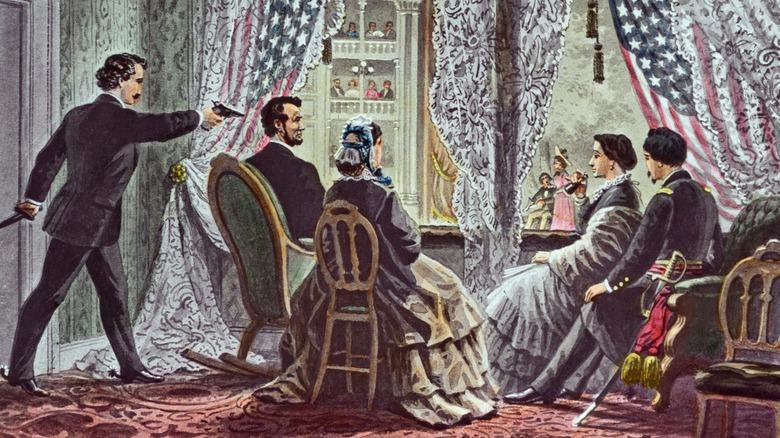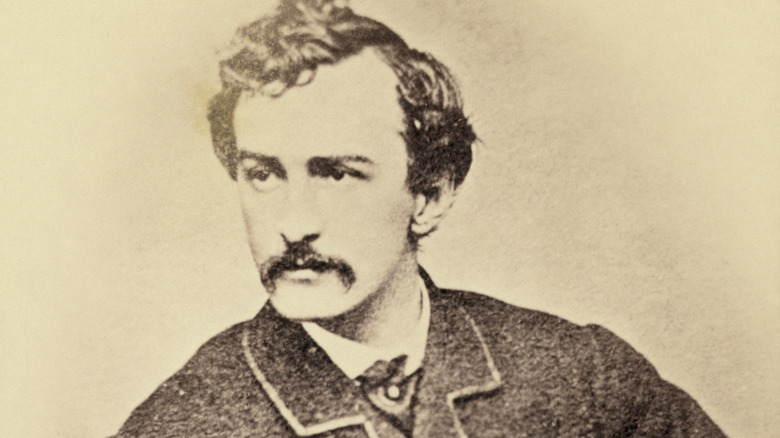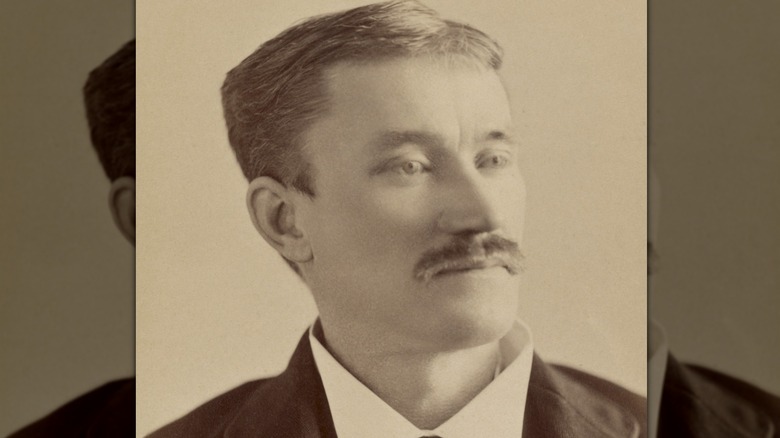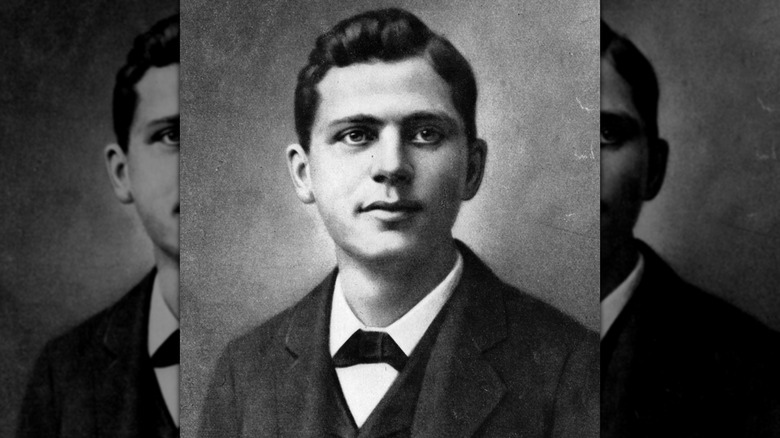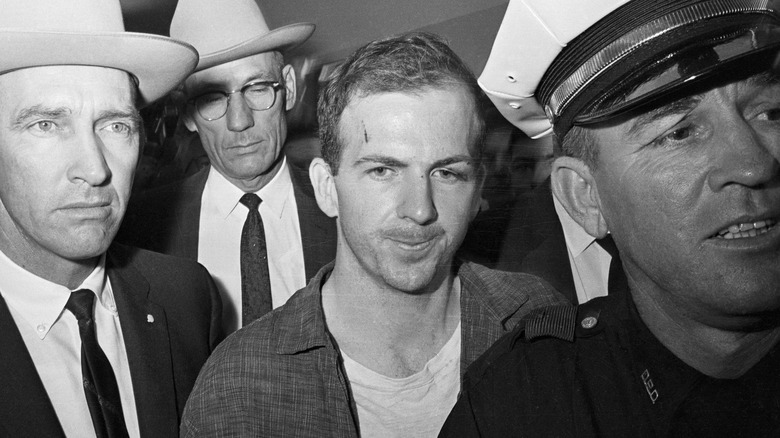What Happened To The Bodies Of These U.S. Presidential Assassins?
While assassination attempts on politicians — or anyone, for that matter — are not necessarily everyday occurrences, they happen far more frequently than you might realize. In the United States, assassins have targeted presidents, president-elects, and presidential candidates with alarming regularity going all the way back to 1835 when Richard Lawrence's pistol misfired as he took aim at President Andrew Jackson. Sometimes assassination attempts completely fail. In certain cases a president gets shot but survives, like Theodore Roosevelt in 1912. Other times someone in the crowd gets hit, like during Giuseppe Zangara's attempted assassination on Franklin Delano Roosevelt in 1933. In four cases, however, a president was shot and killed.
Many people might cite the 1885 assassination of President Abraham Lincoln by disgruntled actor John Wilkes Booth as the most well-known of these plots. Others — perhaps those still alive who remember seeing footage on the news — could cite the 1963 assassination of John F. Kennedy by Lee Harvey Oswald. Less known at this point are the assassinations of James Garfield by Charles J. Guiteau in 1881 and William McKinley by Leon Czolgosz just 20 years later in 1901.
Each presidential assassin died under different circumstances. Booth fled and died in a barn from injuries resulting from his pursuit, Guiteau and Czolgosz were caught and executed, and Oswald was himself assassinated. All four of these men's bodies were buried, but strangely enough, three of them were later exhumed for very different reasons.
[Featured image by Adam Cuerden via Wikimedia Commons | Cropped and scaled]
John Wilkes Booth was buried in a family grave in Baltimore
On April 14, 1865 — five days after Confederate General Robert E. Lee surrendered to Union General Ulysses S. Grant at Appomattox, Virginia — anti-abolitionist John Wilkes Booth shot Lincoln in the back of the head at Ford's Theater. Afterward he jumped to the stage, broke his leg, and escaped on horseback. As the National Parks Service recounts, Booth fled authorities for 12 days over 90 miles until April 26, when Booth and co-conspirator David Herold were surrounded in a tobacco barn. Sergeant Boston Corbett shot Booth in the neck and paralyzed him. He died shortly thereafter, muttering, "Tell my mother I die for my country."
Booth's body was shipped off to the USS Montauk offshore from Washington, D.C. for identification and autopsy purposes. A doctor who had removed a tumor from the killer identified the scar from the surgery, a hotel clerk identified one of his tattoos, and a photographer came to take pictures. As Harper's Weekly reported at the time, "The lips of the corpse were tightly compressed ... his face was pale, and ... his hair was disarranged and dirty." Booth's body was then transported to the Arsenal Penitentiary — a military prison during the Civil War — and buried there. His remains were later exhumed and reburied in a warehouse at the site in 1867. Finally, he was exhumed in 1869, handed over to his family, and reburied at Green Mount Cemetery in Baltimore, where people place pennies on his grave to this day.
Charles J. Guiteau was exhumed and his brain examined
Charles J. Guiteau assassinated James A. Garfield in 1881, only 16 years after President Abraham Lincoln's assassination. Guiteau was a failed evangelical preacher who got a lot of attention for his bizarre courtroom behavior during his trial, and he might have experienced mental health issues. As the Gilder Lehrman Institute of American History recounts, he considered his assassination of Garfield a holy act, compared himself to Moses, and even wrote poetry about it. His tipping point came when President Garfield's administration rejected his job application for a position at the U.S. consulate in Paris. Guiteau then caught up with Garfield on July 2 at Baltimore and Potomac train station and shot him.
Guiteau was hanged on June 30, 1882, nearly one year after the assassination. His body faced a fate as strange as him. Columbia Surgery says that the medical examiners who conducted his autopsy found minor evidence of either malaria or syphilis in his brain, but nothing conclusive. After Guiteau was buried in his Washington, D.C. jail's cemetery, it was later exhumed and transported to the National Museum of Health and Medicine in Maryland for scientific study. The rationale, as The Atlantic explains, was that evidence of Guiteau's "moral insanity" could be found in his brain. He was dissected and his brain and spleen extracted. His brain still exists in a 70% alcohol, 30% water solution in a jar on a shelf in Philadelphia's Mütter Museum. It's unclear what happened to the rest of his body.
Leon Czolgosz was dissolved in acid and buried
It only took 20 years after President James A. Garfield's assassination for Leon Czolgosz to shoot and kill President William McKinley in 1901. As Susan Berfield explains in "The Hour of Fate," Czolgosz's parents had moved from Poland to the United States in search of a better life and gotten crushed by a struggling economy. Jobless, aimless, hopeless, having no prospects or talents, calling himself "Fred Nieman" in German — Fred Nobody — Czolgosz bought a .32 automatic revolver from a hardware store in Buffalo for $4.50 in late August 1901. About a week or so later on September 6 at the technology-focused Pan-American Exposition, President McKinley agreed to meet any member of the public who dropped by to shake his hand. Czolgosz waited in line, and when he reached McKinley, the president held out his hand. Czolgosz lifted his gun and shot him twice.
Unlike Charles J. Guiteau there was no prolonged trial or media circus. Czolgosz's trial lasted less than two days, and his jury deliberated for a mere 30 minutes. By October 29 he was executed via electric chair in Auburn, New York. There's no mention of an autopsy anywhere, and his body wasn't exhumed later for any reason. However, there would have been nothing to exhume, anyway. For some unknown reason Czolgosz's body was dissolved in sulfuric acid before whatever was left was buried in Soule Cemetery in Sennett, New York. The grave is marked "Fort Hill Remains," as Find a Grave shows.
Lee Harvey Oswald was exhumed and re-buried
Much like the other presidents in this article, President John F. Kennedy's assassination came as a complete shock. On November 22, 1963, assassin Lee Harvey Oswald took aim with a rifle from the Texas School Book Depository near Dealey Plaza in Dallas, Texas. At around 12:30 p.m., he opened fire, hitting JFK twice as the president's car passed by. A marine veteran court-martialed twice during his military career for violent behavior, Oswald moved to the Soviet Union when he left the service, moved back to the U.S. in 1962, and developed sympathy for communist Cuba. The next year JFK was dead.
This time, the presidential assassin in question didn't get a chance to face trial or execution. Rather, he faced vigilante vengeance at the hands of nightclub owner Jack Ruby, who assassinated Oswald on November 24, 1963, while the killer was being transported. Conspiracy theories started almost immediately. But despite the Warren Commission finding no such evidence as early as 1964, Oswald and JFK's assassination remained — and remain — the subject of an endless wheel of evermore ridiculous conjecture. This is why, in 1981, Oswald's body was actually exhumed to determine if it really was him and not a Soviet body double, as The New York Times describes. The "skeletal remains" indicated that it was indeed Oswald, who was buried in Rose Hill Cemetery in Fort Worth, Texas. After the examination he was placed back in his grave, where he remains to this day.
